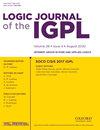概率和不确定性推理的模态语义
IF 0.8
4区 数学
Q2 LOGIC
引用次数: 0
摘要
本文属于概率模态逻辑领域,侧重于对两种不同语义的比较分析:一种植根于克里普克语义,另一种植根于邻域语义。主要区别在于以下几点:后者允许我们充分表达命题的信念函数(低概率),而前者则不行。因此,邻域语义更具表现力。工作的主要部分是研究概率克里普克模型与信念邻域模型的一个子类,即加法模型之间的模态等价性。我们研究如何获得模态等价结构。本文章由计算机程序翻译,如有差异,请以英文原文为准。
Modal semantics for reasoning with probability and uncertainty
This paper belongs to the field of probabilistic modal logic, focusing on a comparative analysis of two distinct semantics: one rooted in Kripke semantics and the other in neighbourhood semantics. The primary distinction lies in the following: The latter allows us to adequately express belief functions (lower probabilities) over propositions, whereas the former does not. Thus, neighbourhood semantics is more expressive. The main part of the work is a section in which we study the modal equivalence between probabilistic Kripke models and a subclass of belief neighbourhood models, namely additive ones. We study how to obtain modally equivalent structures.
求助全文
通过发布文献求助,成功后即可免费获取论文全文。
去求助
来源期刊
CiteScore
2.60
自引率
10.00%
发文量
76
审稿时长
6-12 weeks
期刊介绍:
Logic Journal of the IGPL publishes papers in all areas of pure and applied logic, including pure logical systems, proof theory, model theory, recursion theory, type theory, nonclassical logics, nonmonotonic logic, numerical and uncertainty reasoning, logic and AI, foundations of logic programming, logic and computation, logic and language, and logic engineering.
Logic Journal of the IGPL is published under licence from Professor Dov Gabbay as owner of the journal.

 求助内容:
求助内容: 应助结果提醒方式:
应助结果提醒方式:


